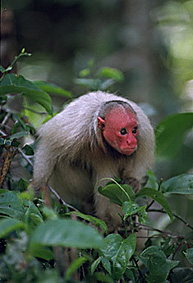The family Cebidae contains 11 genera 58 species (following most recent authors, we exclude the marmosets and tamarins and place them in their own family, the Callitrichidae). Cebids are a strictly American group, currently found from southern Mexico south to northern Argentina. They have been in South America since at least the early Oligocene, when they probably arrived via overwater rafting from Africa.
Cebidae
cebids, including capuchin monkeys, howlers, woolly monkeys, squirrel monkeys, night monkeys, titis, uakaris, and others
Externally, cebids are characterized by long limbs, digits with curved nails (not claws), pollex not opposable and in some cases small or absent, in contrast to a hallux that is large and strongly opposable. These monkeys range in size from small (275g) to moderately large (10kg). They have long and well-furred tails. In some species the tails are prehensile, lacking fur on the underside at the tip and covered with soft, pliable skin. These monkeys are able to use their tails as an "extra arm," hanging by it while they feed or groom with their fore or hind limbs. Cebids lack the ischial callosities that are so prominent in the African cercopithecids. They also lack cheek pouches. Their pelage is usually brown, gray, or reddish; a few species have striking markings, especially on the head.
The skulls of cebids appear globular due to their high braincase and short rostrum. The orbits face forward, corresponding to a high degree of binocular vision. Their bullae lack any bony tube surrounding the auditory meatus. Cebids and related callitrichids are "platyrrhine," meaning that their nostrils are separated by broad internarial pad and face to the side. This contrasts with the catarrhine condition of cercopithecids.
The dental formula of cebids is 2/2 1/1 3/3 3/3 = 36. The presence of a third premolar is a primitive character compared to cercopithecids. The molars have a depression that separates the labial cusps from the lingual ones, which appears to run continuously from tooth to tooth along the toothrow. Cebids also lack a hypoconulid on lower M3; this feature is believed to be a derived condition (synapomorphy).
These monkeys are mostly diurnal, but members of one genus, Aotus, are active primarily at night. Most cebids dwell in tropical forests, where they confine almost all of their activity to the canopy or at least well above the forest floor. Cebids are basically omnivorous, feeding most heavily on fruit and insects, but also taking meat when they can get it. One genus, Alouatta, is folivorous.
These are extremely active, intelligent animals with fantastic climbing ability. Most are vocal to some extent, and many are gregarious, with the social unit usually a family group.
HOME
Primates
Primate FAQ
Primate Species
Monkey Pictures
Search Primates.com
Primates E-Mail Service
New Monkey Species Discovered
Facial Expressions as Guide to Speech
